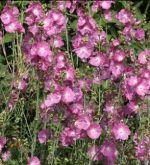 Checkerbloom is a herbaceous perennial in the mallow family, Malvaceae, that also includes hollyhock, cotton, and okra. It is native to western North America from Alberta and British Columbia south to Nevada, Colorado, and Oregon where it grows in prairies, subalpine meadows, chaparral , coastal sage scrub, roadsides and similar habitats. The basal leaves are rounded, lobed and up to three inches across while the stem leaves are palmately lobed with five to seven smooth segments. The lilac to pink and rose flowers have five petals, are one to two inches across, and are carried in loose terminal racemes on stout stems 2-5′ tall during the summer. The plants grow from woody crowns that can be divided in the fall when they die out in the center. Plants like cool climates and do not do well in heat and humidity. A good choice back of the border or for a meadow garden and flowers are good for the vase. The genus name, Sidalcea, is from the Greek words sida ,the name of a water plant ,and alkaia, the Greek word for mallow, and refers to the similarity of the two kinds of plants. The specific epithet malviflora comes from the Latin words malvus meaning mallow, and flos meaning flower, and refers to the similar appearance of the flowers.
Checkerbloom is a herbaceous perennial in the mallow family, Malvaceae, that also includes hollyhock, cotton, and okra. It is native to western North America from Alberta and British Columbia south to Nevada, Colorado, and Oregon where it grows in prairies, subalpine meadows, chaparral , coastal sage scrub, roadsides and similar habitats. The basal leaves are rounded, lobed and up to three inches across while the stem leaves are palmately lobed with five to seven smooth segments. The lilac to pink and rose flowers have five petals, are one to two inches across, and are carried in loose terminal racemes on stout stems 2-5′ tall during the summer. The plants grow from woody crowns that can be divided in the fall when they die out in the center. Plants like cool climates and do not do well in heat and humidity. A good choice back of the border or for a meadow garden and flowers are good for the vase. The genus name, Sidalcea, is from the Greek words sida ,the name of a water plant ,and alkaia, the Greek word for mallow, and refers to the similarity of the two kinds of plants. The specific epithet malviflora comes from the Latin words malvus meaning mallow, and flos meaning flower, and refers to the similar appearance of the flowers.
Type: Herbaceous perennial
Bloom: Lilac to pink and rose flowers one to two inches across with five petals in loose terminal racemes during the summer
Size: 2-5’ H x 3’W
Light: Full sun to light shade
Soil: Average to fertile, moist, well-drained
Hardiness: Zones 5-7
Care: Deadhead to prolong bloom; cut plants to the ground to encourage new foliage; divide to rejuvenate
Pests and Diseases: Japanese beetles
Propagation: Division; species and some cultivars by seed
Companion plants: Yarrows (Achillea), Sea holly (Eryngium) purple coneflower (Echinacea purpurea), baby’s breath (Gypsophila paniculata), ornamental grasses
Outstanding Selections:
‘Brilliant’ (2-2 ½ H, carmine-red flowers)
‘Elsie heugh’ (2-3’ H, pale pink flowers with fringed petals)
‘Loveliness’ (2 ½ H, shell-pink flowers)
‘Mr. Lindbergh’ (2’ H, rosey red flowers)
‘Mrs Anderson’ 3-4’ H, large rose-pink flowers)
‘Oberon’ 2-2 1/2 ‘ H, rose pink flowers)
‘Puck’ (2’ H, clear pink flowers)
‘Rose-Queen’ (3-4’ H, rose-pink flowers)
‘Stark’s Hybrids’ (2-3’ H, pale pink to deep rose flowers)
‘Sussex Beauty’ (3-4’ H, clear pink flowers)
‘William Smith’ (3’ H, salmon flowers)